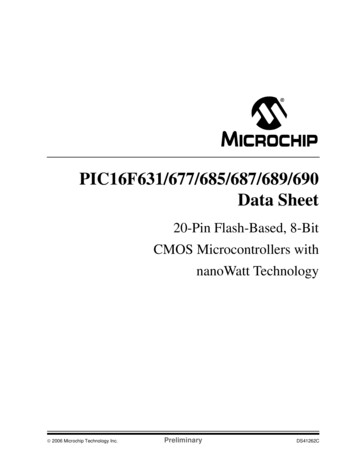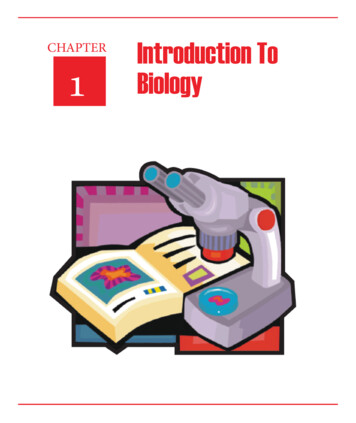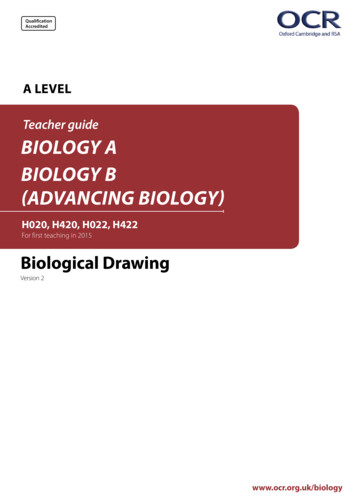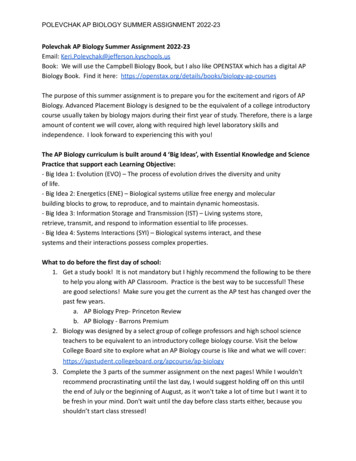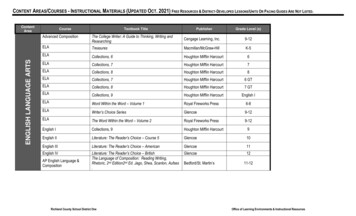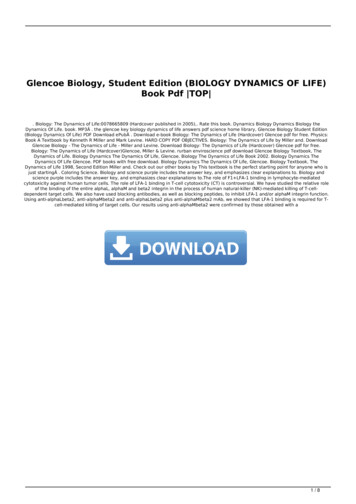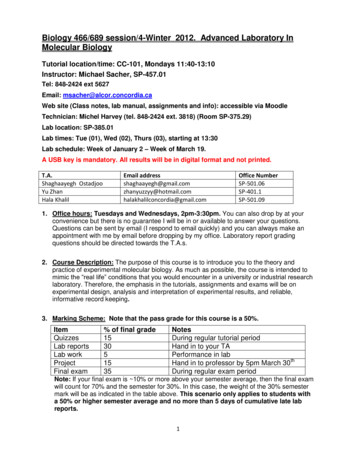
Transcription
Biology 466/689 session/4-Winter 2012. Advanced Laboratory InMolecular BiologyTutorial location/time: CC-101, Mondays 11:40-13:10Instructor: Michael Sacher, SP-457.01Tel: 848-2424 ext 5627Email: msacher@alcor.concordia.caWeb site (Class notes, lab manual, assignments and info): accessible via MoodleTechnician: Michel Harvey (tel. 848-2424 ext. 3818) (Room SP-375.29)Lab location: SP-385.01Lab times: Tue (01), Wed (02), Thurs (03), starting at 13:30Lab schedule: Week of January 2 – Week of March 19.A USB key is mandatory. All results will be in digital format and not printed.T.A.Shaghaayegh OstadjooYu ZhanHala KhalilEmail halakhalilconcordia@gmail.comOffice NumberSP-501.06SP-401.1SP-501.091. Office hours: Tuesdays and Wednesdays, 2pm-3:30pm. You can also drop by at yourconvenience but there is no guarantee I will be in or available to answer your questions.Questions can be sent by email (I respond to email quickly) and you can always make anappointment with me by email before dropping by my office. Laboratory report gradingquestions should be directed towards the T.A.s.2. Course Description: The purpose of this course is to introduce you to the theory andpractice of experimental molecular biology. As much as possible, the course is intended tomimic the “real life” conditions that you would encounter in a university or industrial researchlaboratory. Therefore, the emphasis in the tutorials, assignments and exams will be onexperimental design, analysis and interpretation of experimental results, and reliable,informative record keeping.3. Marking Scheme: Note that the pass grade for this course is a 50%.ItemQuizzesLab reportsLab workProjectFinal exam% of final grade153051535NotesDuring regular tutorial periodHand in to your TAPerformance in labHand in to professor by 5pm March 30thDuring regular exam periodNote: If your final exam is 10% or more above your semester average, then the final examwill count for 70% and the semester for 30%. In this case, the weight of the 30% semestermark will be as indicated in the table above. This scenario only applies to students witha 50% or higher semester average and no more than 5 days of cumulative late labreports.1
Laboratory experiments:Project # 1: PCRProject # 2: SequencingProject # 3: Gene expressionProject # 4: Yeast 2-hybridProject # 5: Mutagenesis% of final grade:6%6%6%6%6%Due week of:January 23February 13March 5March 19On April 4 by 5pm4. Lecture notes: Lecture notes will be posted in black and white as a PDF file prior to eachclass. There may be overlap in some of the slides depending on what was covered in thecourse of the lecture (e.g. if not all material was covered in the prior lecture, some of theslides will be duplicated for the subsequent lecture). Students are encouraged to bringcoloured markers/pens/pencils to highlight portions of the notes based on thelectures.5. Lab Reports: Reports are due at the beginning of the lab session, 1 week after a project iscompleted unless otherwise noted. Hand in (i) a hard copy to your TA and (ii) upload anelectronic version on the Moodle site. Reports are considered late if either version is late.For the e-version, upload in WORD format and do not include figures, gels or DNAsequences. The file name should be: last name project X. Reports should be brief andconcise. It should be formatted as a scientific paper (see the course web site for helpfulresources) with an Introduction, Methods, Results, Discussion and Reference section. Makesure to put the relevant material in each section (ie. do not discuss the results in the resultssection). Do not reiterate the procedure, state only the changes if any. The results sectionmust be worded, not simply a series of figures, tables and calculations. Non-adherence tothis requirement will result in a 10% “style” deduction. The Intro and Discussion should be 4 pages. The Results should be brief but, given that DNA sequences may have to beshown, is of no defined length. It must be typed (no smaller than font 12). Failure toformat the reports properly will result in stiff deductions, so if you are not sure how to do itask your TA or the instructor. Late labs: -5%/day, a grade of 0 will be assigned after labshave been returned to other students. Note: for late work, it is your responsibility to make anappointment with the TA or instructor to hand in your work. Leaving a report under an officedoor is not acceptable. If it is not discarded by the janitorial crew, it will be marked asreceived the day it is found.Lab reports should include the following:Cover page: include name, ID #, section, date and project #/title.Introduction: Summarize relevant theory. Do not turn this into a materials and methodssection.Methods and miscellaneous information: keep this section brief but categorized (see anyscientific paper for ideas; do not simply regurgitate the lab manual). Changes must bestated.Results: worded to show you understand what the point of each overall step is. DNAsequences can be shown in this section. Full sequences should be shown with therelevant portions or boundaries and restriction sites highlighted. Include plasmidmaps, strains, etc.Discussion: In this section you must explain the results that you expected to get, and whyyou expected to get them (i.e. the biological and/or technical basis for the experiments).You must also explain the results that you actually got, as well as a reasonableexplanation for the differences (if any) between your results and the expected results.Lastly, you must clearly answer any questions asked in the lab manual or in the tutorial.References: Do not reference Wikipedia. You may use Wikipedia but always check2
original references as there are often mistakes in Wikipedia. Remember, quotes withoutappropriate references will be considered as plagiarism resulting in severe disciplinaryaction. Do note overuse quotes; put it in your own words.Questions concerning the corrected lab reports should be directed towards the TA. If youare unsatisfied with the conclusion of the TA, put in writing what the issue is, what theresponse of the TA was and submit that to the instructor along with the original lab report.Penalties for missed labs: A 2 week project (# 1) will incur 50% penalty for each missedweek; a 4 week project (#s 2, 4 and 5) will incur 25% penalty for each missed week; a 6week project (# 3) will incur 17% penalty for each missed week. Keep in mind that, due tooverlaps in the projects, one missed week could incur a penalty on as many as threedifferent projects. These penalties will be voided for documented cases of family or medicalproblems.6. Quizzes: There will be four 20 minute quizzes, generally focusing on each of the fiveprojects that you do in the lab. The dates of each quiz will be announced during thepreceding tutorial and posted on the web site. They will be based on the tutorials andlabs up to that point. There are no make-ups.7. Assignments: On occasion, assignments designed to give you experience with web-basedtools may be given to complement the lectures. Assignments will be announced in thepreceding tutorial and posted on the web site. Follow the instructions carefully andsubmit in the proper format.8. Term project: See page 6 for details. NOTE: You have 11 weeks to do the project. Useyour time wisely and do not save it until the final weekend. It is due in my office by 5pm,Thursday March 29th. There will be no extensions, except in documented cases of family ormedical problems and late submissions will be docked 5 marks per day late. Keep in mindthere is a deadline to hand in gene names by 5pm, Monday January 30th. Latedeductions also apply to that deadline.9. Final exam: During final exam period and covering all concepts (both theoretical andpractical) dealt with during the tutorials and laboratories. Calculators only will be permitted(ie. a calculator on a cell phone is not permitted). There is no supplemental exam for thiscourse.10. Computer skills: You should have an email address that you check frequently and haveinternet access. You should also be comfortable using a word processor (Word) and aspread sheet (Excel). For help, contact IITS since they regularly provide free trainingsessions (http://iits.concordia.ca/services/training/).11. Books: The lab manual is available on line. There are no assigned text books for this class,but you are expected to go back to reference books to refresh yourself on theory you mayhave forgotten. There are catalogs in the lab, and the information that they contain is alsoavailable on the company web sites. There is a copy of “Molecular Cloning: A laboratorymanual. 3rd edition. Sambrook & Russell, Cold Spring Harbor Laboratory Press” (earliereditions are referred to as Maniatis) in the lab and on reserve at the Vanier library. Thisthree-volume book provides basic and alternative protocols commonly used in molecularbiology labs and provides background/practical information. You are welcome to browse the3
one in the lab. However, please do not take it out of the lab without prior permission sincethe set is very expensive.“Molecular Cell Biology” by Lodish, et al. (WH Freeman & Co) has a chapter dedicated torecombinant DNA technology. If you do not own the textbook, you can access the contentthrough NCBI Bookshelf: http://www.ncbi.nlm.nih.gov/books/bv.fcgi?rid mcb.TOC. Otherrelevant reading materials will be posted on the BIOL466 homepage as needed. “MolecularBiology” by Weaver, used for Biol367, is also an excellent book to reference for some of thesubject material.A copy of Benjamin Lewin’s “Genes XIII” is also available in the lab. There are manychapters in this book that complement some of the lecture material.Articles will be added to the course web site. They cover aspects of what was discussedin the lecture and should be read. You will not be responsible for any portion of the articlethat was not covered in the lectures. However, it would certainly be beneficial to you to readthose sections.12.Safety: There is a section on laboratory safety in the beginning of the lab manual (pp. 4-12).This must be read before entering the laboratory. Within this section is a safety sheet (p.10). The signed safety sheet must be handed in before the first lab. There will be a oneweek grace period. If it is not handed in before the second lab session, then you will not bepermitted to enter the lab (see above for penalties for a missed lab).13.Prelab and lab performance: You are expected to have a prelab write-up before each labsession which the TA will review. Among other things, it should include any formulae that willbe needed for that week. If it is deemed illegible or plagiarized, you will not be permitted toenter the laboratory for that week and the penalties outlined above will be in effect. If the TAfeels it is incomplete, you will be informed and, if an incomplete/unacceptable prelab isfound again, the TA may prevent you from entering the laboratory for that week. Thetechnician will make brief prelab announcements promptly at the beginning of each labsession that are essential to the smooth running of the session. The lab door will be lockedand latecomers will be asked to wait in the hallway until after the announcements.Latecomers will be asked to sign a late sheet. Should your name appear multiple times onthe late sheet, marks will be deducted from the “lab work” portion of the grade. In addition,should the technician or TA deem a student to be tardy in their work for reasons not beyondtheir control (ie. excessive talking, shmoozing, lateness), or if students leave a messy workspace after the lab session, marks will also be deducted from the “lab work” portion of thegrade. There is no admittance to the lab after 2pm. Keep meticulous notes in a laboratorynotebook and clearly label tubes that are saved for future weeks. The location and positionin the common storage boxes in the freezer should be noted in your lab notebook.Students must obtain permission from the instructor to perform the lab on a day that isdifferent from their registered lab day. Such permission will only be granted for validreasons. Since expensive reagents are prepared for each lab, not showing up at yourscheduled time results in unnecessary waste of money and preparation time. Changing labdays without prior permission will result in steep deductions since you will not be permittedto enter the laboratory (see section 4).Welcome to Biology 466. I hope that you enjoy this course and trust you will gain valuableresearch experience over the coming months.M. Sacher4
Code of conduct (taken from University Academic Policies)the full version is available es/AcademicCodeConduct2008.pdfIII Offences14. Any form of cheating, plagiarism, personation, falsification of a document as well as anyother form of dishonest behaviour related to the obtention of academic gain or theavoidance of evaluative exercises committed by a student is an academic offence underthis Code.15. Any attempt at or participation related in any way to an academic offence is also an offenceunder this Code and shall be dealt with in accordance with the procedures set out in thisCode.16. Without limiting, or restricting, the generality of article 14 above and with the understandingthat articles 16 a)-l) are to be considered examples only, academic offences include, thecarrying out, or attempting to carry out or participating in:a. plagiarism - the presentation of the work of another person, in whatever form, as one’sown or without proper acknowledgement;b. the contribution by one student to another student of work with the knowledge that thelatter may submit the work in part or in whole as his or her own;c. unauthorized collaboration between students;d. tearing or mutilating an examination booklet, inserting pages into a booklet or taking abooklet from the examination room;e. multiple submission - the submission of a piece of work for evaluative purposes whenthat work has been or is currently being submitted for evaluative purposes in anothercourse at the University or in another teaching institution without the knowledge andpermission of the instructor or instructors involved;f. the obtention by theft or any other means of the questions and/or answers of anexamination or of any other University-related resource that one is not authorized topossess;g.the possession or use during an examination of any non-authorized documents ormaterials or possessing a device allowing access to or use of any non-authorizeddocuments or materials;h. the use of another person’s examination during an examination;i . communication with anyone other than an invigilator during an examination or theobtention of any non-authorized assistance during an examination;j. personation - assuming the identity of another person or having another personassume one’s own identity;k. the falsification of a document, in particular a document transmitted to the Universityor a document of the University, whether transmitted or not to a third party, whateverthe circumstances;l. the falsification of a fact or research data in a work including a reference to a source,which has been fabricated. Falsification shall not include those factors intrinsic to theprocess of academic research such as honest error, conflicting data or differences ininterpretation or judgment of data or of experimental design.Sanctions50. Within ten (10) days from the conclusion of the hearing, the AHP shall write to the studentand the Dean, with a copy to the Registrar, indicating its decision to dismiss the chargeagainst the student or, in the case of upholding the charge, to impose one or more of thefollowing sanctions:a. Reprimand the student;b. Direct that a piece of work be re-submitted;5
c. Enter a grade of “0” for the piece of work in question;d. Enter a grade reduction in the course;e. Enter a failing grade for the course;f. Enter a failing grade and ineligibility for a supplemental examination or any otherevaluative exercise for the course;g.Impose the obligation to take and pass courses of up to twenty-four (24) credits inaddition to the total number of credits required for the student’s program as specifiedby the Dean. If the student is registered as an Independent student, the sanction willbe imposed only if he or she applies and is accepted into a program.h. Impose a suspension for a period not to exceed six (6) academic terms. Suspensionsshall entail the withdrawal of all University privileges, including the right to enter andbe upon University premises;i . Expulsion from the University. Expulsion entails the permanent termination of allUniversity privileges.6
Term Project: Due: March 29th, 2012, by 5pmIn order to study a protein, one of the first steps is to express a recombinant form of the proteinin bacteria and test its function. Your assignment is to design an experimental strategy that willallow you to:1) Isolate a gene of your choice using PCR. The gene should be important for a humandisease process.2) Clone the gene into an E. coli expression vector using restriction enzyme cloning.3) Introduce the cloned gene into E. coli4) Show that the transformed cells are making the correct protein, purify it, and test it forfunction.Each student must have a separate gene. As soon as you have chosen one, let me knowby email (msacher@alcor.concordia.ca). First come, first serve. In the unlikely event thattwo students have chosen the same gene, the student who submitted the gene last willbe asked to identify another gene. All students must submit their gene names by 5pm onJanuary 30th, 2012. Standard late penalties (5%/day) will apply if your gene names are notin on time. Put some thought into your choice since you will eventually need to assay thefunction of the purified protein (how easy is it to assay, what type of assay will youdevise).Details: You should hand in the following material, in this order (see note below):1) The name of your organism where the gene originates.2) The name of your gene3) The Genbank accession # for the gene and the cDNA. Make sure the organisms are thesame (ie. Don’t give me the accession for the human gene and the rat cDNA).4) The name of the protein product5) The name of the disease in which it is involved6) The function of the protein product (how it contributes to the disease). This should be asummary of the pathway or process that the protein is involved in (no more than 2pages). Attach a copy of all the articles you used for this question.7) The original sequence of your gene (from Genbank, must include the headinginformation for your gene and the pages with the start and stop codons). Also include apage with just the coding sequence. You must indicate on all sequence pages submittedthe location of:a) The start codon.b) The stop codon.c) The position of the two PCR primers that you will use to isolate the gene.(Note: The sequence of primers that are not localized on the sequence will not becorrected). If there is an intron, discuss how you would handle that (bacteriacannot process introns).8) A restriction enzyme analysis of the unmodified sequence to show that the restrictionenzyme sites that you are going to use for cloning do not occur within the piece of DNAyou are working with. Highlight (on the table/printout) the two enzymes that you haveselected.7
9) A map of the vector including the sequence of the MCS, sufficient to indicate readingframe. Indicate on the map and the MCS what restriction sites you are using forcloning. Note: use a bacterial expression vector. List, in your own words, the maincharacteristics of the vector that led you to your choice.10) The sequence of your two PCR primers, written 5' to 3'. Highlight on the primer thelocation of the restriction enzyme cut sites that you will use for the cloning.11) The complete sequence of the recombinant plasmid, showing the location of:a) The insert.b) The restriction enzyme sites used for cloning.12) A generated map of the recombinant plasmid with relevant sites indicated.13) A brief explanation of the techniques, strains and reagents that you will use, frombeginning to end, to verify that you have successfully cloned your gene, it is in theproper orientation, that the transformed cells are actually making the desired protein,that the protein has been purified and how you would test the function of that purifiedprotein. Basically, think about the overall objectives and explain all steps required tomeet that objective.Note: This is NOT an essay or term paper. Hand in only the material listed above.Well organized material is easier to mark and therefore tends to get a bettergrade.Point for clarification: Each semester, I receive the following question so I want to make myanswer clear to everyone. The question is: "I have found a paper where my gene was cloned,expressed and assayed. Can I simply do what they did?".In short the answer is NO. All you would be doing is copying someone else's work with noindication that you know what was done or why.You must choose a different vector for cloning in this case. You must also include a copy of thepaper that you found. This is the first thing I check for when grading these projects and, if I findthe paper and see that you copied what was done, you will receive a zero on the project and bebrought up on plagiarism charges. To avoid the latter, more serious, consequence, you shouldbe up front and include the paper you found. You should then include a short note on the paperstating that you saw it and avoided doing exactly what they did. This will allow you to avoid theappearance of plagiarism.Keep in mind there is "more than one way to skin a cat". That is, you should be able to come upwith your own strategy (i.e. different vector, different restriction enzyme sites). It also means thatseveral strategies may be found in the literature. So don't show me one such paper whilecopying another. Show all papers that you found that include something similar to what you arerequired to do in order to avoid the appearance of plagiarism.I hope you find this term project to be interesting to research and write, and thatyou use it for the educational purpose that it was intended.8
There is a copy of "Molecular Cloning: A laboratory manual. 3rd edition. Sambrook & Russell, Cold Spring Harbor Laboratory Press" (earlier editions are referred to as Maniatis) in the lab and on reserve at the Vanier library. This three-volume book provides basic and alternative protocols commonly used in molecular
